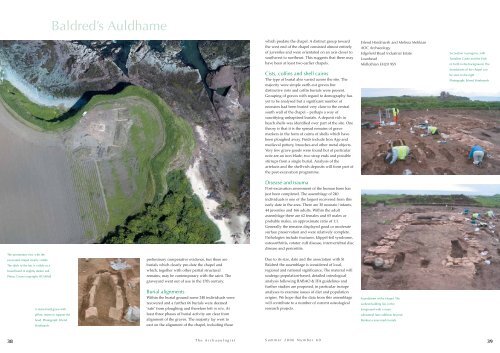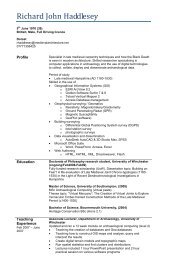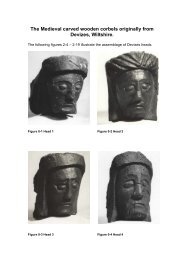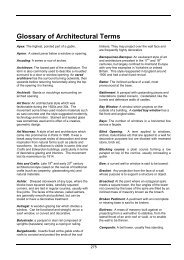The ARCHAEOLOGIST - English Late-Medieval timber-framed ...
The ARCHAEOLOGIST - English Late-Medieval timber-framed ...
The ARCHAEOLOGIST - English Late-Medieval timber-framed ...
You also want an ePaper? Increase the reach of your titles
YUMPU automatically turns print PDFs into web optimized ePapers that Google loves.
Baldred’s Auldhame<br />
which predate the chapel. A distinct group toward<br />
the west end of the chapel consisted almost entirely<br />
of juveniles and were orientated on an axis closer to<br />
southwest to northeast. This suggests that there may<br />
have been at least two earlier chapels.<br />
Cists, coffins and shell cairns<br />
<strong>The</strong> type of burial also varied across the site. <strong>The</strong><br />
majority were simple earth-cut graves but<br />
distinctive cists and coffin burials were present.<br />
Grouping of graves with regard to demography has<br />
yet to be analysed but a significant number of<br />
neonates had been buried very close to the central<br />
south wall of the chapel – perhaps a way of<br />
sanctifying unbaptised burials. A deposit rich in<br />
beach shells was identified over part of the site. One<br />
theory is that it is the spread remains of grave<br />
markers in the form of cairns of shells which have<br />
been ploughed away. Finds include Iron Age and<br />
medieval pottery, brooches and other metal objects.<br />
Very few grave goods were found but of particular<br />
note are an iron blade, two strap ends and possible<br />
stirrups from a single burial. Analysis of the<br />
artefacts and the shell-rich deposits will form part of<br />
the post-excavation programme.<br />
Erlend Hindmarsh and Melissa Melikian<br />
AOC Archaeology<br />
Edgefield Road Industrial Estate<br />
Loanhead<br />
Midlothian EH20 9SY<br />
Excavation in progress, with<br />
Tantallon Castle and the Firth<br />
of Forth in the background. <strong>The</strong><br />
foundations of the chapel can<br />
be seen to the right.<br />
Photograph: Erlend Hindmarch<br />
Disease and trauma<br />
Post-excavation assessment of the human bone has<br />
just been completed. <strong>The</strong> assemblage of 240<br />
individuals is one of the largest recovered from this<br />
early date in the area. <strong>The</strong>re are 30 neonate/infants,<br />
44 juveniles and 166 adults. Within the adult<br />
assemblage there are 62 females and 65 males or<br />
probable males, an approximate ratio of 1:1.<br />
Generally the remains displayed good or moderate<br />
surface preservation and were relatively complete.<br />
Pathologies include fractures, klippel-feil syndrome,<br />
osteoarthritis, rotator cuff disease, intervertebral disc<br />
disease and periostitis.<br />
<strong>The</strong> promontory fort, with the<br />
excavated chapel clearly visible.<br />
<strong>The</strong> ditch of the fort is visible as a<br />
broad band of slightly darker soil.<br />
Photo: Crown copyright: RCAHMS<br />
A stone-lined grave with<br />
pillow stones to support the<br />
head. Photograph: Erlend<br />
Hindmarch<br />
preliminary comparative evidence, but there are<br />
burials which clearly pre-date the chapel and<br />
which, together with other partial structural<br />
remains, may be contemporary with the saint. <strong>The</strong><br />
graveyard went out of use in the 17th century.<br />
Burial alignments<br />
Within the burial ground some 240 individuals were<br />
recovered and a further 66 burials were deemed<br />
‘safe’ from ploughing and therefore left in situ. At<br />
least three phases of burial activity are clear from<br />
alignment of the graves. <strong>The</strong> majority lay west to<br />
east on the alignment of the chapel, including those<br />
Due to its size, date and the association with St<br />
Baldred the assemblage is considered of local,<br />
regional and national significance. <strong>The</strong> material will<br />
undergo population-based, detailed osteological<br />
analysis following BABAO & IFA guidelines and<br />
further studies are proposed, in particular isotope<br />
analyses to examine issues of diet and population<br />
origins. We hope that the data from this assemblage<br />
will contribute to a number of current osteological<br />
research projects.<br />
Foundations of the chapel. <strong>The</strong><br />
earliest building lies in the<br />
foreground with a more<br />
substantial later addition beyond.<br />
Bamboo canes mark burials.<br />
38<br />
<strong>The</strong> Archaeologist Summer 2006 Number 60<br />
39





